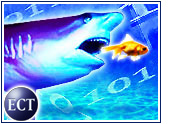
Pity the people with summer birthdays or anniversaries. Their milestones often go overlooked amid the rush to beat traffic to the beach or get the barbecue fired up.
July is also the month in which Intel was born, and while it may have been easy to overlook this milestone in the past, the chip giant turned 35 in 2003. It’s not exactly 50 or 100, but 35 years is practically a millennium for a technology firm.
Of course, others share space on the calendar with the chipmaker. Onetime dot-com darling Webvan went under in July 2001, taking with it the hopes and dreams of many a would-be tycoon.
Think the two anniversaries have nothing in common? Think again.
Middle Aged?
Intel employees recently buried a time capsule to mark their company’s birthday. Such an act is the ultimate in confidence, a statement that they fully expect to be around in another 35 years to dig it up and reminisce. Otherwise, what’s the point?
And why not? For a technology company to be fluid and agile enough to not only survive, but also thrive and dominate, for 35 long years is plenty of reason to be upbeat about the future. If 35 is possible, why not 350?
That same optimism no doubt flowed through Louis Borders’ veins when the book tycoon convinced venture capitalists to bankroll a revolutionary new company that would use the Web to deliver something everyone needs. Food, after all, is universal.
Short Story
In short, Webvan was formed to address a market that already existed, whereas Intel was formed long before many of the markets it now serves, including the desktop and portable computer industries, came into being.
In hindsight, it’s easy to see how Intel put itself squarely in the path of success, especially by setting up shop in Silicon Valley. But at the time, the Valley wasn’t much of a crossroads, let alone the hub of the tech universe, which had yet to experience its big bang.
On paper, and without the benefit of hindsight, it appears that Intel was the riskier bet. Sure, it had a management team with a strong track record and some incipient demand for its products. But its market was limited at the outset; in fact, the company even set modest goals for itself.
Webvan, by comparison, seemed like it couldn’t miss. When the company opened its doors, people, as always, needed food. They also loved the Web. They were so busy making money on the Web that they couldn’t fathom driving all the way to the grocery store. Talk about a can’t-miss proposition.
Whys and Wherefores
As everyone knows by now, Webvan did miss, and brutally. It’s far from alone, but its demise is as fitting a symbol for why dot-com mania was doomed as Intel’s success is proof that the next big thing probably isn’t even on the radar screen.
Intel didn’t just happen upon its lengthy success, of course. It has survived boom and bust cycles, hired and laid off, adapted and acquired. And today, in a time when everyone is ready to get on with the recovery already, Intel seems able to lean on that track record.
It exhibits patience where others panic and takes a long view when the only thing that seems to matter to some people is what happened this quarter. Maybe if Webvan and its contemporaries had thought to bury a time capsule when they were founded, things might have been different. Especially if the time capsules were full of cash.
Note: The opinions expressed by our columnists are their own and do not necessarily reflect the views of the E-Commerce Times or its management.
















































An interesting light read for a story. What one might call a feature story. Anniversaries, etc. But for this audience, it seems it needs a bit more analysis. You don’t tell us WHY you think Webvan failed while Intel survived. This story needs more meat.
SL